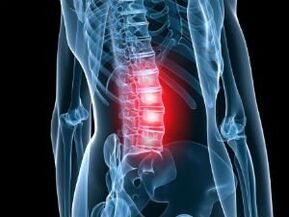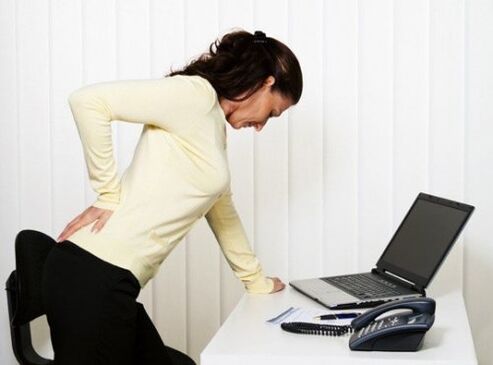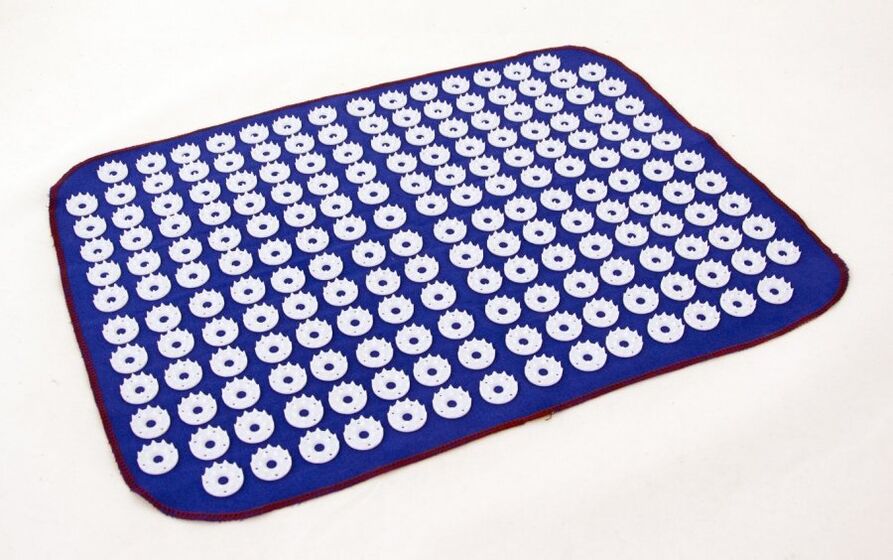
According to medical statistics, back pain in 80% of cases caused by lumbar osteochondrosis.This is due to degenerative-dystrophic changes in this segment, when the intervertebral and adjacent vertebral discs are affected.Lumbar spinal osteochondrosis (SPEP) is indicated by a variety of symptoms: pain in different properties, mobility limitations, lower body sensitivity, and more.In the absence of long treatment, degenerative processes apply to vertebra, reduce work capacity, so patients can be disabled.
To prevent harmful complications of lumbar osteochondrosis (PO), you need to start comprehensive treatment at 1-2 pathological stages.In the case of advanced, when irreversible changes in the disc or vertebra are already present, surgery is performed.To prevent lower osteochondrosis, and related complications, it is necessary to carry out its prevention.
The development of lumbar osteochondrosis
To understand what pop osteochondrosis is (lumbar spine), you need to study the structure of the spinal column.It is made up of vertebrae, between cartilage gaskets (intervertebral discs).The disc is covered with a hard fibrous membrane (fibrous ring), where there is a pulpoose nucleus.This structure performs a function that absorbs shock, making the spine more flexible.
Reference.The daily lumbar segment of the spine is subject to a large load, as it holds the upper weight.Therefore, lower spinal osteochondrosis is diagnosed more frequently than the cervix, chest.
With the usual load on the spine, the disc compressed, many fluids disappear, their height is reduced, and the distance between the vertebrae decreases.Cartilaginus gasket becomes fragile, microcabby appears on its surface, where the pulpoose core stands out of time.With further compression of the intervertebral disc, the outer membrane and the loss of gelatin body, the form of the hernia.Then the pathological movement of the vertebra occurs, the burden on the spinal segment increases.
Shortly thereafter, bone growth (osteophytes) began to form on the edge of the vertebral body.Therefore, the body tries to stabilize the spine.
Doctors distinguish 4 stages of lumbar spinal osteochondrosis:
- 1 degree - a problem with the disc starting, the middle of the dehydration, it is flattened, the crack appears on the outer shell.It's blocked.
- 2 degrees - cartilage gaskets, vertebrae approach each other, become more portable, muscles and ligaments around the spine.Pain appears.
- 3 degrees - protrusion, hernia, vertebral subluxation are formed.Increased pain, limited mobility, lower body sensitivity.
- The 4th degree osteochondrosis is characterized by the appearance of osteophytes that can damage the spinal cord, neighboring vertebrae.There is persistent pain, mentioned neurological disorders and other complications, the risk of increased defects.
It is the easiest to cure lumbar chondrosis (Level 1), however, is very difficult to detect the disease at this stage.Osteochondrosis intervertebral degrees in -2 treated using conservative methods.At stages 3-4, surgery may be required.
Reference.According to statistics, SPP is more frequently detected in patients after 30 years.There are frequent pathological cases in people after 20 years.About 80% of 60 -year -old patients experience a manifestation of the disease.
Cause
To understand how to handle osteochondrosis of pcm (lumbosacral spine), you need to know the reason:
- A normal static or dynamic load on the lumbar segment.Risk groups for the development of osteochondrosis include office workers, professional athletes (heavy athletes), movers, builders, etc.
- Breach of posture, stay prolonged in the wrong pose.
- Genetic predisposition, anomaly of vertebral body formation.This category includes young software - spinal column curvature caused by vertebral body pathology.
- Spinal column injury.
- Hormone imbalance, metabolic disorders, endocrine diseases that interfere with metabolism in the lumbar segment.
- Changes related to the body provoke disc discs.
- Bone tuberculosis, osteomyelitis (inflammation of the bone tissue), ankylosing spondylitis (vertebral and joint inflammation), rheumatoid arthritis, etc.
Often, the disease causes several causes at once.
In addition, there are factors that cause the development of lumbar osteochondrosis:
- Excessive weight.
- Passive lifestyle, prolonged chairs.
- The use of dangerous foods (fatty foods, fried foods, sugar -gula, half -finished products, etc.).
- Liquid deficiency, dehydration.
- Congenital disorders of the spinal structure, for example, additional vertebrae.
- Usually wearing uncomfortable heels.
- The duration of the fetus, then the load on the spinal column increases.
- Sharp neglect for professional athlete training or excessive sports in people who were previously passive.
- The use of alcohol, frequent and disrespectful.
There are many other factors that can launch the degenerative-dystrophic process in the lumbar spine.For example, flat feet, frequent hypothermia, frequent stress, sleep disorders, etc.

Symptom
Symptoms of lumbar spinal osteochondrosis are diverse, they depend on the pathological level and localization of the affected area.
Doctors distinguish reflex and compression syndrome (symptom complex) for SPP.The first occurs with irritation of the outer membrane receptor, ligaments, articular capsules, and the last - when compressing nerve files, blood vessels, spinal cords.
There are reflex syndrome such as lumbar osteochondrosis:
- Lumbago.Shooting pain in the lower back with sharp movements or tension.On a small attempt to move, the pain syndrome is enhanced, so the patient freezes in one pose.The muscles in the damaged area are very tense, on the palpation, the painful sensation becomes clearer.This manifestation is associated with the movement of the pulpoose nucleus inside the external shell.
- Lumbalgia.Real pain develops for several hours or days.Discomfort is increasing with movement, changes in body position.It is weak when someone takes a horizontal pose with a roller below his lower back.When raising the legs straight in this position, the pain increases (Lassa's symptoms).The level of muscle tension is less than with lumbar.The lower back mobility is limited.
- Sciatica.The painful (acute or painful) sensation is spread from the lower body to the lower body.There is an increase in this feature during movement.Poor pain when resting in the back.The muscles in the affected area are tense, the pain syndrome is expressed on the palpation.
Symptoms in compression syndrome depend on the damaged part of the lumbar segment.Signs of characteristics are associated with cerebrospinal nerve compression with hernia, osteophytes, transferred vertebra.This condition is called radiculopathy, where the pain is increasing with a slight step, the lower back muscles, and limited mobility.
Clinical manifestations of compression syndrome depend on damaged vertebrae from the lumbar segment:
- L1 - L3 - pain and numbness in the lower back, front and internal surface of the thigh, it is difficult for the patient to bend/release the legs in the knee.
- L4 - The pain syndrome spreads to the thigh, falling to the knee (behind).In the same area, sensitivity is violated.
- L5 - a painful sensation is transmitted into the back, the outside of the thigh, falling on the front of the lower leg to the inside of the leg and thumb.In the same area, the numbness is felt, it is difficult for the patient to bend the thumb.
- S1 - Painful spill from the bottom to the back, the outer surface and the posterior of the thigh, falling to the outside of the lower leg, feet.In this area, the feeling of feeling is felt, the lower leg muscles are weak, so the patient is difficult to stand on the socks.
There is a risk of damage to several nerve beams at once, for example, L5, S1.If the hernia shifts, then it can squeeze the spinal cord.
With the lower blood vessel compression, the possibility of weakening the muscles -the leg, numbness from the lower leg, violation of control over the urinary process and removal.In men, erections are disrupted in men, and in women the main symptoms can be supplemented by inflammation of the ovarian or uterus.
Steps -The diagnostic step
To diagnose SPP, the doctor examines the patient, performs palpation to determine the condition of the muscles and identify the spinal curvature.It is important to tell the specialist in detail the symptoms to make it easier for him to make a diagnosis.
Instrumental research will help detect intervertebral osteochondrosis:
- The lower train (direct back and lateral projection).
- Calculated tomography and magnets.
X -ray allows you to evaluate pop structure.To identify the pathological mobility of the vertebra, X -Ray is performed in a curved and advanced position.This study allows us to see that the intervertebral gap has narrowed down, the corpses of the vertebra have shifted, osteophytes appeared on their side.However, this diagnostic method is considered outdated.
Today, CT and MRI are increasingly being used to detect degenerative-dystrophic changes in the spine.These very informative studies allow you to evaluate the state of vertebra, disc, intervertebral holes, spinal cord.With their help, highlights, hernia directions, stages of nerve compression, spinal cord, blood vessels are lowered.
Treatment
Medicines for lumbar osteochondrosis

Pop osteochondrosis treatment lasts from 1-3 months to 1 year.The success of therapy depends on the patient himself, which should adhere to the doctor's recommendation.With self -medication, the patient's condition usually worsens.
Therapy therapy:
- Stop or weaken the symptoms of software.
- To identify the cause of the disease, try to exclude it from life.
- Eliminates the inflammation process.
- Recover blood circulation, metabolic processes in the lumbar region.
- Try to improve the condition of the damaged cartilage gasket, stop the degenerative change.
To achieve such a goal, it is recommended to carry out complex therapy.It usually starts with taking medicine:
- Musorelaxants.They relax the muscles, undermine pain and inflammation.
- NSAID.They have anti -inflammatory, analgesic, antipyretic effects.
- Antispasmodics.They help stop smooth muscle cramps, undermine pain.
- Anesthetic agent.They are used for severe pain in the form of therapeutic restrictions.
- Glucocorticosteroids.They also help overcome pain.However, these funds can destroy bones, so they take them for a short time and only after the doctor's approval.
- Sedative.Remove neuromuscular tension, increase sleep.
- Vitamins (Group B, E, C, A).Recover the affected nerves, weakening the pain.
Be careful.NSAIDs are prohibited from taking gastritis or stomach ulcers, as they are more likely to damage the mucous membranes of the gastrointestinal tract.
With severity, the patient was injected with injection, and after stopping the main symptom, he took the oral agent.
In addition, external products are used (gel, ointment, cream, waste).
The question of what to do with chronic chronic osteochondrosis is quite relevant.If the SPP becomes chronic, then after the main symptoms are the patient, the patient is prescribed chondroprotectors, medications that restore blood circulation, vitamin B. medications. They help restore conservation, normalize blood supply to the affected area, and prevent further pathological development.
Treatment of lumbar spinal chondrosis (stage 1) is performed using chondroprotectors which slows down the development of degenerative processes, accelerating cartilage generation.In addition, the patient is prescribed a vitamin-mineral complex.This form of osteochondrosis is easiest to curse.
Other conservative methods
With okz (osteochondrosis) 1 - 2 degrees, the following treatment procedures will help stop its development:
- Ultrasound therapy weakens pain and inflammation, normalizing blood flow to damaged areas.
- Dutenzor therapy is a safe traction of the spine because of your own weight, after normalization of muscle tone, mobility improves.
- Magnetotherapy reduces the pain and inflammation of the muscles around the spine.
- Reflexotherapy (introduction of needles into bioactive points on the body) accelerates blood circulation, relieves inflammation and swelling.
- Manual therapy (exposure to affected areas with the doctor's hands) and massage normalizes muscle tone, reduces nerve compression, increases intervertebral disc power, and restores spinal structure.
- Electrophoresis allows you to deliver medical solutions through the skin to the bones and cartilage.
- Dragonvalization improves blood circulation, metabolic processes, reduces pain, restores skin sensitivity.
There are still many effective procedures that will help improve the patient's condition in the 5-15 session.The main thing is to receive a doctor's approval before their behavior.
Home treatment at home
If you are interested in whether it is possible to treat OPP at home, then consult your doctor.If a specialist has authorized, then start therapy, which usually consists of the following:
- Diet.If lumbar osteochondrosis is caused by a violation of blood flow or metabolism, then it does not include fat, fries, spicy foods, eggs, etc. from the menu, adding menu with fresh vegetables, fruits, low meat, meat, fish, sour products -milk.Reject alcohol, tonic drinks (tea, coffee).Drink filtered water, compot, herbal tea.
- To restore blood circulation, exercise or use rubbing and compress.
- Sleep on orthopedic mattresses, low pillows.If you have inactive work, then buy a chair with a back that will support the spine.From time to time, apply a special corset or belt.
- Exercise therapy will help strengthen the muscle corset, removing part of the burden of the diseased spine.Complex for each patient individually makes a doctor or instructor.
- Do yourself in the lumbar region.However, find out how to do it right with professionals.
- Use folk medicine in the form of rubbing, compressing, bathing, etc.
- Acupuncture is a plastic plate with many spikes that improve blood circulation, metabolic processes in damaged areas, reduce muscle aches, relieve.

And also at home you can use lotions with herbal decoctions, plaster.
Reference.Novelty in the treatment of osteochondrosis is a suitable massager bed even for the most irregular patients.
However, keep in mind that you can only be treated at home after the permission of the attending physician.
Surgical
Operations with lumbar osteochondrosis are prescribed if the conservative method has been ineffective for a long time.As well as surgical interventions are characterized by voluntary urine, tail syndrome and horse tail syndrome (pinching lower spinal cord).
In the treatment of SPP, the surgical method is used:
- Spondylodeza - adjacent vertebra fusing.
- Fassetextomy - the removal of the intervertebral joints that violate the cerebrospinal nerve.
- Laminectomy - removal of plate that covers the spinal cord of spinal cord.
- Discoctomy is a complete or partial removal of the intervertebral disc, which causes nerve compression or spinal cord.
- Corpectomy - removal of vertebral body and adjacent cartilage gasket.Then the blanks are filled with bone transplant and 3 segments of the vertebrate are spent.
Reference.After surgical intervention, there is a risk of complications: spinal cord trauma, nerve beams, transplantation, infection, etc.
After treatment, it is necessary to undergo a recovery to speed up the recovery.
Complication
In the absence of competent therapy, the risk of lumbar osteochondrosis complications increases:
- Disc hernia, pinching the nerve root or spinal cord.
- The long inflammatory process increases the likelihood of radiculitis (nerve root inflammation).
- Ishias (inflammation of the sciatic nerve), in which the pain and numbness of severe pain occur.
- In the case of blood circulation affected spinal cord, the possibility of compression myelopathy (spinal cord compression with various formations: bone fragments, hernia, tumors, hematomas).
- Horse tail syndrome is a lower spinal cord compression, leading to infarction of intestinal function, pelvic organs, and lower leg.
To avoid such complications, you need to start treatment as early as possible.
Prevention
To prevent lumbar osteochondrosis, follow the following rules:
- Leading a relatively active lifestyle (walking more often on foot, exercising regularly, signing up for the pool).
- When sitting, warm every 1.5 hours.
- Sleep in orthopedic mattresses.
- Avoid excessive physical work, lifting the severity of only half of the pre -accommodation, before, place on a special belt at the bottom.
- Buy orthopedic shoes.
- Eat properly, take the vitamin-mineral complex as prescribed by the doctor.
- Learn to rest.
- Try not to hypothermia.
- In time, treat a disease that can cause SPP.
- Reject bad habits.
Subject to this suggestion, you can avoid degenerative changes in the spine and improve your health.
The most important thing
If you see the symptoms of lumbar osteochondrosis, consult your doctor immediately.Free treatment can worsen your condition and cause complications.Lumbar chondrosis (stage 1) is treated with exercise therapy, physiotherapy and chondroprotectors.In later stages, medicines, massages, manual therapy, and others are used.In the absence of positive dynamics for a long time or the appearance of neurological symptoms, doctors may prescribe surgery.Patients must follow the doctor's recommendation to expedite recovery.



































